
|

|
|
Home Site Search Contact Us Subscribe
|
|
|
Notes from the Giardini - La Biennale di Venezia 2014 "Fundamentals" is certainly not the typical way one would think of displaying architecture. By Terri Peters June 24, 2014 The 14th International Architecture Biennale in Venice this year is curated by Rem Koolhaas and, for the first time, he curated all three of the main sections of the show. The Arsenale venue takes as its theme “Elements of Architecture” and the visitor experiences 15 components of building. In a very organized and methodological route the Modern building is dissected: ceiling, window, corridor, floor, balcony, fireplace, façade, roof, door, wall, ramp, stair, toilet, escalator, and elevator. Each element democratically, and strangely, gets its own discussion. It is certainly not the typical way one would think of displaying architecture.
Architecture without architects is Koolhaas’s theme, but actually, the visitor is left to wonder why. What is the message here: Architecture as graphic design? Architecture as research? Architecture as a kit of parts of building components? Buildings are for people – but absent here are the users and a building’s site. Why diminish the role of the architect and why examine individual parts of modern buildings rather than thematically explore architectural concepts? Is it acceptable to say that site, the role of the architect, experience, specificity of place, are just too conceptually messy to be classified? There are many ways to structure a discussion or provocation around the theme of Modernism. Defining architectural concepts such as repetition, threshold between inside and outside, sequence of spaces, the architectural parti would have been perhaps a more satisfying way to showcase the experimentation inherent in Modern buildings.
But Koolhaas knows that it will irk architects to see something as complex and experimental and important as Modernism chopped into digestible bits fit for palatable consumption. (But he also knows we like nice graphics, simple bites of history, and that we will buy the t-shirts. I am writing this wearing my red “Stair” t-shirt.) The theme does invite debate given that the audience is almost all architects and likely all are, or were, trained by fundamentalist Modernists. Is Koolhaas’s defiant focus on the banal, the everyday, the mundane, a fitting way to explore the meaning and influence of Modernism? Well researched and neatly presented, “Fundamentals” is no bore, but conceptually – is less really more? Should we try harder because the next step for Modernism is a tough one – building renovation, urban revitalization, sustainable design, and accessible urban places are just a few of the current and upcoming challenges we face in this legacy.
A second curated space is called “Monditalia,” where Koolhaas shows what he calls his “scan of Italy” through film, dance, theater, and music. He also set the overall theme of the national pavilions “Absorbing Modernity 1914-2014,” which are largely on show in the Giardini site. In the catalogue he argues that the national pavilions “portray a terrifying century: almost every country was destroyed, divided, occupied, drained, traumatized, yet survived.”
The exhibition at the Giardini, a large garden venue with architecturally varied national pavilions dotted around the landscape, allows visitors to sample how each country presents its attitudes to Modernism. So much work goes into each installation that it allows the possibility of a Grand Tour in one afternoon. These pavilions show that there is no one Modernism, no cohesive approach or attitude. Each country responds independently and critically to themes such as architectural representation; the changing relationship to nature; influences of technology; attitudes to interiors; and regional social contexts.
A few particular highlights are the German Pavilion, exhibiting “Bungalow Germania,” a 1:1 experience of the Chancellor’s Bungalow, designed in 1964 and used as the official residence. Visitors can walk around the office, living room, kitchen, bathroom, and other areas, actually experiencing the Modernist spaces. The texture, transparency, furnishings, and indoor-outdoor connections are all first hand, at full scale. A deceptively simple concept, it was a quirky, immersive experience.
The Japan Pavilion’s “In the Real World” is a packed room full of people, models, text, and color. It is hard to find a common thread other than the critique of Modernization and mass-consumption, but the depth of concept and detail is almost overwhelming. The Netherlands Pavilion, “Open: A Bakema Celebration,” took a different approach, going deep into the work of one architect, Jaap Bakema (1914-1981). The visionary architect created many of the most important buildings of the Dutch welfare state, including the Lijnbaan shopping street in Rotterdam and many innovative social housing schemes. The Austria Pavilion deflects attention away from itself with “Plenum: Places of Power,” a presentation of physical models of national parliament buildings around the world. Each is white, 1:500 scale, and mounted side by side on the wall. Alphabetically arranged, it is interesting to note which belongs to each country, and the size differences spark discussions between visitors. Roof plans are not a typical way to view these, or any, buildings, and the white forms on white walls gives enough abstraction for them to be viewed as a collection.
“Fair Enough” in the Russian Pavilion is witty and has visitors puzzling. Spoiler alert: If you are about to go to the Biennale I would suggest do not read this paragraph and make sure to visit the Russian Pavilion. “Fair Enough” is a mock international trade fair – a sort of performance art meets architectural critique. Visitors are met with uniformed trade show hosts in the different stalls selling certain themes and products. For example, a tour guide might try to sell you on a Soviet architecture tour of different countries – a tour of the U.K. suburbs or Vietnam to look at Soviet housing. Another stall sells the visitor on a Dacha, or second home, to store things instead of a storage locker. It was amusing just watching the reactions of fellow visitors as they realized that the actors in the stalls were in character, acting. It did take a few minutes to see that this was tongue in cheek. A witty way of commenting on the commercialization of Modernism, the contrived internationalization of the Modern style, and the bizarre ways that cultures appropriate each other’s standards, it is unique in its forward-looking, funny, and interesting take on how we can look critically at Modernism.
Keep room in the luggage for the 15 small “Elements” catalogues – they show more of the extensive research that went into the exhibition by Koolhaas´s team and students at Harvard Graduate School of Design. The Biennale runs until November 23, 2014.
Terri Peters is an architect, writer, and researcher. www.terripeters.net
Also by Peters:
Diverse offerings demonstrated that while classic mid century modern Danish design is inspiring it in the past new generation is looking towards sustainable and human centered designs Exhibition Review: "Yes is More": BIG at DAC, Copenhagen Though the firm housing projects are amazing and their enthusiasm is great the comic book graphics are bit much it hard not to roll your eyes but definitely worth the roll Field Notes from the 11th Venice Architecture Biennale - Part 2 The Giardini Experimental Architectures offers glimpse of 30 countries current architectural debates and experiments Field Notes from the 11th Venice Architecture Biennale - Part 1 The Arsenale Betsky eclectic curating and the polished and thoughtful presentations of the exhibitors make it challenging entertaining and provocative show Architecture Supermodels: Report from SmartGeometry Conference Parametric design is set to revolutionize the way buildings are designed and built
Exhibition Review: "The 60s: Montral Thinks Big" at the Canadian Centre for Architecture The 1960s just long enough ago to be familiar yet far enough in the past to look back at this time of radical urban redevelopment with some degree of objectivity Exhibition Review: "RED + WHITE: Canadians in Design" at Canada House, Trafalgar Square, London The future of Canadian design on show in London features rocket suits tea pots leather boots and more from Canada hottest young talent
|
(click on pictures to enlarge) 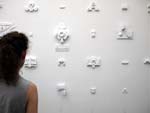 Terri Peters Austria: “Plenum: Places of Power” presents roof-plans models of national parliament buildings around the world. 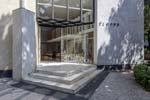 Andrea Avezz¨, Courtesy la Biennale di Venezia Netherlands: ”Open: A Bakema Celebration” 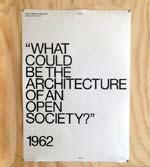 Terri Peters Netherlands: ”Open: A Bakema Celebration” 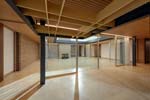 Andrea Avezz¨, Courtesy la Biennale di Venezia Germany: “Bungalow Germania” is a full-scale installation of the 1964 Chancellor’s Bungalow.  Andrea Avezz¨, Courtesy la Biennale di Venezia Russia: “Fair Enough: Russia’s Past Our Present” is a mock international trade fair – a sort of performance art meets architectural critique.  Andrea Avezz¨, Courtesy la Biennale di Venezia Russia: “Fair Enough: Russia’s Past Our Present”  Andrea Avezz¨, Courtesy la Biennale di Venezia Russia: “Fair Enough: Russia’s Past Our Present”  Terri Peters Russia: “Fair Enough” includes a sales pitch to buy a dacha as a second home to store things 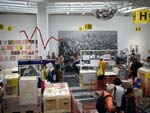 Terri Peters Japan: “In the Real World” is packed with models, text, and color. 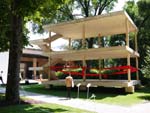 Terri Peters Architect Valentin Bontjes van Beek and students from the Architectural Association in London built a full-size model of Le Corbusier's Maison Dom-Ino in front of the Arsenale. 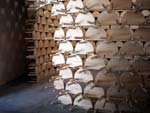 Terri Peters Kosovo: “Visibility (imposed modernity)” is an arrangement of 692 traditional wooden shkami stools creating a monument from one of the country's oldest and most common furniture elements.  Terri Peters Morocco, in its first appearance at the Biennale, presents “Fundamental(ism)s.” Set in a bed of desert sand, it shows housing proposals from the past and plans for the future - focusing on architectural concepts for adapting Modernism to specific climatic conditions. 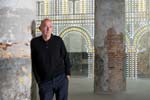 ę Gilbert McCarragher Rem Koolhaas in front of Luminaire at the Arsenale. |
ę 2014 ArchNewsNow.com